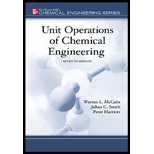
Concept explainers
(a)
Interpretation:
Molal flux of
Concept Introduction:
The formula to calculate molal flux for the equimolar diffusion of gas A through gas B is:
Here,
(a)
Answer to Problem 17.1P
Molal flux of
Explanation of Solution
Given information:
Diffusion of
Pressure,
Temperature,
Mole fraction of
Mole fraction of
Distance between point A and B,
Volumetric diffusivity,
The whole gas phase is stationary.
Nitrogen diffuses at the same rate as carbon dioxide in opposite direction.
For an ideal gas at standard temperature and pressure
Use equation (1) to calculate the molal flux of
(b)
Interpretation:
The net mass flux for the given process of diffusion is to be determined.
Concept Introduction:
The formula to calculate mass flux for the equimolar diffusion of gas A through gas B is:
The formula to calculate mass flux for the equimolar diffusion of gas B through gas A is:
Total mass flux will be:
Here,
(b)
Answer to Problem 17.1P
The net mass flux for the given process of diffusion is,
Explanation of Solution
From part (a), the molar flux of
Molar flux of
Molar masses of CO2 and N2 are taken as:
Use equations (2) and (3) to calculate the mass flux of CO2 and N2 as:
Use equation (4) to calculate the net mass flux as:
(c)
Interpretation:
The speed of the observer at which the net mass flux relative to the observer becomes zero is to be determined.
Concept Introduction:
The formula that relates the molar flux of A with its concentration and velocityis:
The formula that relates the molar flux of B with its concentration and velocity is:
Concentration of a species is defined as:
(c)
Answer to Problem 17.1P
The speed of the observer from point A at which the net mass flux relative to the observer becomes zero is,
The speed of the observer from point B at which the net mass flux relative to the observer becomes zero is,
Explanation of Solution
From part (a), the molar flux of
Molar flux of
Calculate the concentration of CO2 and N2 at point A and at point B as:
Calculate the velocities of CO2 and N2 at point A and at point B. Use the numerical values of the flux.
The mass flux of CO2 and N2 through a reference plane in terms of the velocity of the moving observer
Since the velocity of the observer at the point of zero net mass flux is to be calculated, mass flux of CO2 must be equal to the mass flux of N2. Thus,
Now, use the above equation to calculate the observer velocity for point A as well as point B as:
(d)
Interpretation:
The speed of the observer at which the nitrogen is stationary relative to the observer is to be determined.
Concept Introduction:
The formula that relates the molar flux of A with its concentration and velocity is:
The formula that relates the molar flux of B with its concentration and velocity is:
Concentration of a species is defined as:
(d)
Answer to Problem 17.1P
The speed of the observer from point A at which the nitrogen is stationary relative to the observer is,
The speed of the observer from point B at which the nitrogen is stationary relative to the observer is,
Explanation of Solution
For the nitrogen phase to appear stationary to the observer, the speed of the observer must be equal to the speed of nitrogen and in the direction of the diffusion of nitrogen.
At point A,
At point B,
(e)
Interpretation:
Molal flux of CO2 relative to the observer in part (d) is to be estimated.
Concept Introduction:
The molal flux of A through a reference plane in terms of the velocity of the moving observer
(e)
Answer to Problem 17.1P
Molal flux of CO2 relative to the observer in part (d) at point A is,
Molal flux of CO2 relative to the observer in part (d) at point B is,
Explanation of Solution
Velocity of the observer at points A and B from part (d) is:
The molar flux of CO2 through a reference plane in terms of the velocity of the moving observer
At point A, the molar flux of CO2relative to the observer is calculated as:
At point B, the molar flux of CO2 relative to the observer is calculated as:
Want to see more full solutions like this?
Chapter 17 Solutions
Unit Operations of Chemical Engineering
 Introduction to Chemical Engineering Thermodynami...Chemical EngineeringISBN:9781259696527Author:J.M. Smith Termodinamica en ingenieria quimica, Hendrick C Van Ness, Michael Abbott, Mark SwihartPublisher:McGraw-Hill Education
Introduction to Chemical Engineering Thermodynami...Chemical EngineeringISBN:9781259696527Author:J.M. Smith Termodinamica en ingenieria quimica, Hendrick C Van Ness, Michael Abbott, Mark SwihartPublisher:McGraw-Hill Education Elementary Principles of Chemical Processes, Bind...Chemical EngineeringISBN:9781118431221Author:Richard M. Felder, Ronald W. Rousseau, Lisa G. BullardPublisher:WILEY
Elementary Principles of Chemical Processes, Bind...Chemical EngineeringISBN:9781118431221Author:Richard M. Felder, Ronald W. Rousseau, Lisa G. BullardPublisher:WILEY Elements of Chemical Reaction Engineering (5th Ed...Chemical EngineeringISBN:9780133887518Author:H. Scott FoglerPublisher:Prentice Hall
Elements of Chemical Reaction Engineering (5th Ed...Chemical EngineeringISBN:9780133887518Author:H. Scott FoglerPublisher:Prentice Hall
 Industrial Plastics: Theory and ApplicationsChemical EngineeringISBN:9781285061238Author:Lokensgard, ErikPublisher:Delmar Cengage Learning
Industrial Plastics: Theory and ApplicationsChemical EngineeringISBN:9781285061238Author:Lokensgard, ErikPublisher:Delmar Cengage Learning Unit Operations of Chemical EngineeringChemical EngineeringISBN:9780072848236Author:Warren McCabe, Julian C. Smith, Peter HarriottPublisher:McGraw-Hill Companies, The
Unit Operations of Chemical EngineeringChemical EngineeringISBN:9780072848236Author:Warren McCabe, Julian C. Smith, Peter HarriottPublisher:McGraw-Hill Companies, The





